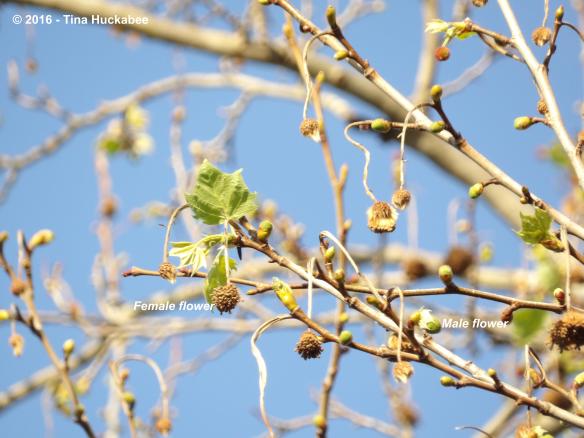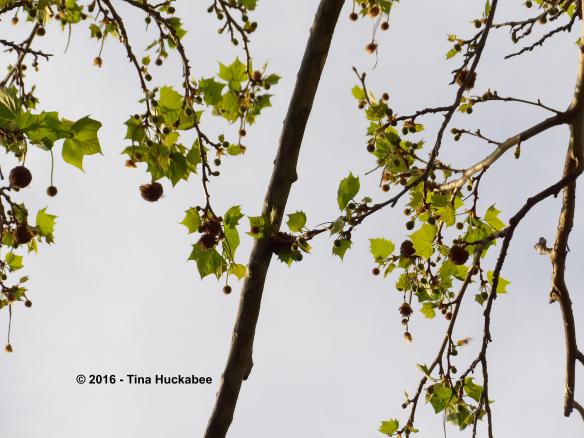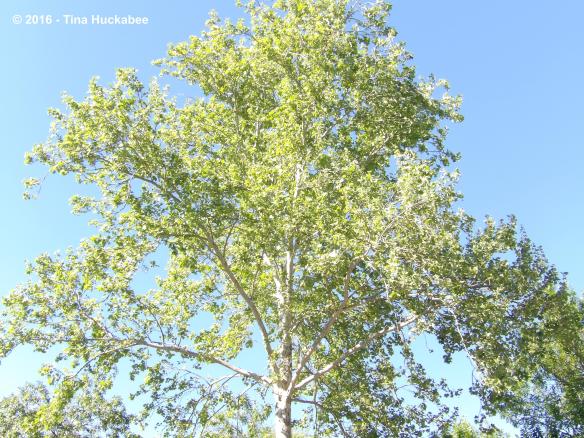My American Sycamore, Platanus occidentalis, leafed out this past month. It began the month in a mostly leafless state.

The Sycamore, at the center-left, leafs out later than the Shumard Oak (Quercus shumardii).
It wasn’t too far into March before dots of new green appeared. I caught the beginning of the leafy action, snapped photos, then went on with my life.

This branch is the only one that is below the roof of my house and therefore, easily accessible. I have no plans to climb on top my roof to get photographs of leaves for this blog.
Sycamore, like most plants, is a monecious plant, which means that each tree has both female (pistillate) flowers and male (staminate) flowers. As an aside, another way that plants function reproductively is by being dioecious–which means that the individual plants are either female or male. Fewer plants are dioecious.
I knew that American Sycamores were monecious, but seeing that the tree is monecious is another thing entirely–and that’s the great thing about tree following: I notice these things because I’m paying attention. I assumed that because my tree is tall that I wouldn’t get a good photo of the male and female flowers. Additionally, I wasn’t trying to get photos of the flowers. But during in the photo-snapping session mentioned above, I caught both the male and female flowers.
The male flowers grow on newer, shorter branchlets and the female flowers grow on older branchlets.
The male flowers sport a sort nubby look along the branches, while the female flowers are fuzzier. The male flower will break and release its pollen load, usually by wind, but also, by water. If you recall from our March visit to the Sycamore, we learned about dispersal of seeds by wind, anemochory, and dispersal by water, called hydrochory. The American Sycamore does both; it’s a good survival strategy to employ a couple of methods of reproduction–it certainly keeps the options open.
Sycamore leaf production soon overtakes any flower show, though.
You can see that there are plenty of seed-balls for next year’s Sycamore seed dispersal. For now, the new ones are spring green,
…but eventually they’ll turn a toasty, autumn brown.
I’ve never seen a nest in the Sycamore, but it serves as a consistent resting spot for a variety of birds like this male Great-tailed Grackle, Quiscalus mexicanus. .
His glorious, purple-black plumage pairs well with the new leaves. Other birds like White-winged Doves, House Sparrows, Blue Jays, and Cardinals, are year-round visitors to my Sycamore. As the leaves grow larger and the foliage thickens, it will become more difficult to spot birds resting in the tree.
The foliage is now almost fully flushed out. Sycamore is usually planted as a shade tree, but also as a tree for urban areas used to thwart air pollution.
Maybe those big leaves will save us all.
This is the American Sycamore as it enters late spring heading toward the summer months.
Thanking Pat of The Squirrelbasket for graciously hosting this fun meme about trees. Check out her blog for interesting information about trees from all over the world.
















Fascinating series of pictures! That’s the trouble when spring arrives, suddenly everything happens at once.
That bit with the male and female flowers was very informative.
And I particularly like the new green leaves against the blue sky. Call me a traditionalist!
All the best 🙂
LikeLike
Thanks, Pat. You’re right though about spring–there’s so much happening and so quickly that it’s hard to keep up. I’d never really noticed the differences between the male and female flowers and probably wouldn’t have except that I have this monthly date with Tree Following. So, thanks for hosting!!
LikeLike
Lovley photos – and how wonderful to have Red Cardinals!
LikeLike
Thank you. Cardinals are quite the little jewels in the garden!
LikeLike
I’ve always been fascinated by Sycamore trees–especially the seeds and flowers. I agree: Tree following helps you to notice, observe, and enjoy all the stages of the tree’s growth.
LikeLike
Sycamores are really lovely trees–so decorative. I like this tree following business; I guess I need the discipline of having a meme obligation in order to learn. 🙂
LikeLike
Thanks for the explanation of the Sycamore flowers – I had wondered about that. It’s such a pleasure to see all the trees leaf out.
LikeLike
You’re welcome! It was interesting to see the differences and the read that, yes indeed, there are actually two different flowers at the same time. It’s lovely to see the trees green up.
LikeLike
I too love seeing the male and female flowers and how it leafs out and forms flowers…we don’t see many sycamores around my area.
LikeLike
I recall that Sycamores aren’t quite as far north as where you are. The flowers were fun to discover and notice.
LikeLike
Nice documentation of a pretty tree. Of course all the pictures are lovely but the one of the flowers against the overcast sky really speaks to me. I think of the sycamore as being a really old plant. It seems slightly alien like. I wonder if all flowering plants were originally monecious.
LikeLike
I’ve wondered about the monecious thing too–it would make some sense from an evolutionary standpoint, wouldn’t it?
LikeLike
What a great series of photographs! Spring is a favorite time of year for me. I love following the trees from that first blush of color when you’re almost not sure it’s there–when you see the forms of the trees as you do in winter, but every so faintly colored. (I’m a tree lover and even enjoy them bare in the winter when you can really look at the shapes–like a skeleton!)
LikeLike
Thank you! Spring is just about the best. Like you, I love the first “blush” of color and I agree that trees are beautiful in their bare state, the skeleton look. Thanks for dropping by!
LikeLike
gosh your tree has been busy Tina, it is nice when the fresh leaves come on the trees, I am fascinated by the hang flowers and seed pods on these trees, they are so decorative, also they would catch the wind better for pollination and seed dispersal,
one of the things I like most about tree following is that I notice the details that would otherwise pass me by, Frances
LikeLike